[English] 日本語
 Yorodumi
Yorodumi- EMDB-23939: Cryo-EM structure of the human SSU processome, state pre-A1 - raw maps -
+ Open data
Open data
- Basic information
Basic information
| Entry | Database: EMDB / ID: EMD-23939 | |||||||||
|---|---|---|---|---|---|---|---|---|---|---|
| Title | Cryo-EM structure of the human SSU processome, state pre-A1 - raw maps | |||||||||
 Map data Map data | Main map | |||||||||
 Sample Sample |
| |||||||||
| Function / homology |  Function and homology information Function and homology informationmRNA N-acetyltransferase activity / U6 snRNA 2'-O-ribose methyltransferase activity / oocyte growth / nucleologenesis / snoRNA localization / leucine zipper domain binding / granular component / tRNA wobble cytosine modification / U4atac snRNP / tRNA cytidine N4-acetyltransferase activity ...mRNA N-acetyltransferase activity / U6 snRNA 2'-O-ribose methyltransferase activity / oocyte growth / nucleologenesis / snoRNA localization / leucine zipper domain binding / granular component / tRNA wobble cytosine modification / U4atac snRNP / tRNA cytidine N4-acetyltransferase activity / rRNA acetylation involved in maturation of SSU-rRNA / 18S rRNA cytidine N-acetyltransferase activity / regulation of stem cell population maintenance / tRNA acetylation / U4atac snRNA binding / CURI complex / UTP-C complex / negative regulation of amyloid precursor protein biosynthetic process / pre-snoRNP complex / t-UTP complex / Pwp2p-containing subcomplex of 90S preribosome / Mpp10 complex / rRNA (pseudouridine) methyltransferase activity / box C/D sno(s)RNA binding / rRNA modification / histone H2AQ104 methyltransferase activity / preribosome / dense fibrillar component / histone methyltransferase binding / box C/D sno(s)RNA 3'-end processing / rRNA methyltransferase activity / endonucleolytic cleavage in 5'-ETS of tricistronic rRNA transcript (SSU-rRNA, 5.8S rRNA, LSU-rRNA) / endonucleolytic cleavage of tricistronic rRNA transcript (SSU-rRNA, 5.8S rRNA, LSU-rRNA) / regulation of centrosome duplication / regulation of transcription elongation by RNA polymerase II / N-acetyltransferase activity / endonucleolytic cleavage to generate mature 5'-end of SSU-rRNA from (SSU-rRNA, 5.8S rRNA, LSU-rRNA) / cilium disassembly / box C/D methylation guide snoRNP complex / embryonic cleavage / tRNA export from nucleus / positive regulation of rRNA processing / RNA splicing, via transesterification reactions / rRNA primary transcript binding / transcription elongation factor activity / blastocyst formation / sno(s)RNA-containing ribonucleoprotein complex / rRNA base methylation / SUMOylation of RNA binding proteins / U4 snRNA binding / telomerase holoenzyme complex / U2-type precatalytic spliceosome / spindle assembly involved in female meiosis / protein localization to nucleolus / epigenetic programming in the zygotic pronuclei / rRNA methylation / box C/D snoRNP assembly / negative regulation of RNA splicing / neural precursor cell proliferation / U3 snoRNA binding / neural crest cell differentiation / negative regulation of bicellular tight junction assembly / protein acetylation / precatalytic spliceosome / rRNA modification in the nucleus and cytosol / NRAGE signals death through JNK / preribosome, small subunit precursor / erythrocyte homeostasis / snoRNA binding / Formation of the ternary complex, and subsequently, the 43S complex / cytoplasmic side of rough endoplasmic reticulum membrane / Cul4-RING E3 ubiquitin ligase complex / negative regulation of ubiquitin protein ligase activity / rRNA metabolic process / Ribosomal scanning and start codon recognition / Translation initiation complex formation / Association of TriC/CCT with target proteins during biosynthesis / positive regulation of transcription by RNA polymerase I / negative regulation of telomere maintenance via telomerase / decidualization / RNA polymerase II complex binding / TFIID-class transcription factor complex binding / TOR signaling / Protein hydroxylation / SARS-CoV-1 modulates host translation machinery / cellular response to ethanol / mTORC1-mediated signalling / Peptide chain elongation / negative regulation of apoptotic signaling pathway / Selenocysteine synthesis / Formation of a pool of free 40S subunits / chromosome, centromeric region / positive regulation of intrinsic apoptotic signaling pathway by p53 class mediator / Eukaryotic Translation Termination / blastocyst development / negative regulation of ubiquitin-dependent protein catabolic process / SRP-dependent cotranslational protein targeting to membrane / Response of EIF2AK4 (GCN2) to amino acid deficiency / ubiquitin ligase inhibitor activity / Viral mRNA Translation Similarity search - Function | |||||||||
| Biological species |  Homo sapiens (human) Homo sapiens (human) | |||||||||
| Method | single particle reconstruction / cryo EM / Resolution: 3.51 Å | |||||||||
 Authors Authors | Vanden Broeck A / Singh S / Klinge S | |||||||||
| Funding support |  United States, 2 items United States, 2 items
| |||||||||
 Citation Citation |  Journal: Science / Year: 2021 Journal: Science / Year: 2021Title: Nucleolar maturation of the human small subunit processome. Authors: Sameer Singh / Arnaud Vanden Broeck / Linamarie Miller / Malik Chaker-Margot / Sebastian Klinge /  Abstract: The human small subunit processome mediates early maturation of the small ribosomal subunit by coupling RNA folding to subsequent RNA cleavage and processing steps. We report the high-resolution ...The human small subunit processome mediates early maturation of the small ribosomal subunit by coupling RNA folding to subsequent RNA cleavage and processing steps. We report the high-resolution cryo–electron microscopy structures of maturing human small subunit (SSU) processomes at resolutions of 2.7 to 3.9 angstroms. These structures reveal the molecular mechanisms that enable crucial progressions during SSU processome maturation. RNA folding states within these particles are communicated to and coordinated with key enzymes that drive irreversible steps such as targeted exosome-mediated RNA degradation, protein-guided site-specific endonucleolytic RNA cleavage, and tightly controlled RNA unwinding. These conserved mechanisms highlight the SSU processome’s impressive structural plasticity, which endows this 4.5-megadalton nucleolar assembly with the distinctive ability to mature the small ribosomal subunit from within. | |||||||||
| History |
|
- Structure visualization
Structure visualization
| Movie |
 Movie viewer Movie viewer |
|---|---|
| Structure viewer | EM map:  SurfView SurfView Molmil Molmil Jmol/JSmol Jmol/JSmol |
| Supplemental images |
- Downloads & links
Downloads & links
-EMDB archive
| Map data |  emd_23939.map.gz emd_23939.map.gz | 50.7 MB |  EMDB map data format EMDB map data format | |
|---|---|---|---|---|
| Header (meta data) |  emd-23939-v30.xml emd-23939-v30.xml emd-23939.xml emd-23939.xml | 18.1 KB 18.1 KB | Display Display |  EMDB header EMDB header |
| FSC (resolution estimation) |  emd_23939_fsc.xml emd_23939_fsc.xml | 19.8 KB | Display |  FSC data file FSC data file |
| Images |  emd_23939.png emd_23939.png | 147.7 KB | ||
| Masks |  emd_23939_msk_1.map emd_23939_msk_1.map | 669.9 MB |  Mask map Mask map | |
| Others |  emd_23939_additional_1.map.gz emd_23939_additional_1.map.gz emd_23939_half_map_1.map.gz emd_23939_half_map_1.map.gz emd_23939_half_map_2.map.gz emd_23939_half_map_2.map.gz | 625.2 MB 541.8 MB 541.9 MB | ||
| Archive directory |  http://ftp.pdbj.org/pub/emdb/structures/EMD-23939 http://ftp.pdbj.org/pub/emdb/structures/EMD-23939 ftp://ftp.pdbj.org/pub/emdb/structures/EMD-23939 ftp://ftp.pdbj.org/pub/emdb/structures/EMD-23939 | HTTPS FTP |
-Validation report
| Summary document |  emd_23939_validation.pdf.gz emd_23939_validation.pdf.gz | 509.6 KB | Display |  EMDB validaton report EMDB validaton report |
|---|---|---|---|---|
| Full document |  emd_23939_full_validation.pdf.gz emd_23939_full_validation.pdf.gz | 509.1 KB | Display | |
| Data in XML |  emd_23939_validation.xml.gz emd_23939_validation.xml.gz | 27.6 KB | Display | |
| Data in CIF |  emd_23939_validation.cif.gz emd_23939_validation.cif.gz | 36.7 KB | Display | |
| Arichive directory |  https://ftp.pdbj.org/pub/emdb/validation_reports/EMD-23939 https://ftp.pdbj.org/pub/emdb/validation_reports/EMD-23939 ftp://ftp.pdbj.org/pub/emdb/validation_reports/EMD-23939 ftp://ftp.pdbj.org/pub/emdb/validation_reports/EMD-23939 | HTTPS FTP |
-Related structure data
| Related structure data |  7mq8C  7mq9C  7mqaC 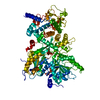 7mqjC C: citing same article ( |
|---|---|
| Similar structure data | |
| EM raw data |  EMPIAR-10781 (Title: Nucleolar maturation of the human small subunit processome EMPIAR-10781 (Title: Nucleolar maturation of the human small subunit processomeData size: 74.6 TB Data #1: Unaligned multi-frame micrograph movies of human SSU processomes - Dataset 1 [micrographs - multiframe] Data #2: Unaligned multi-frame micrograph movies of human SSU processomes - Dataset 2 [micrographs - multiframe] Data #3: Unaligned multi-frame micrograph movies of human SSU processomes - Dataset 3 [micrographs - multiframe] Data #4: Unaligned multi-frame micrograph movies of human SSU processomes - Dataset 4 [micrographs - multiframe] Data #5: Unaligned multi-frame micrograph movies of human SSU processomes - Dataset 5 [micrographs - multiframe] Data #6: Unaligned multi-frame micrograph movies of human SSU processomes - Dataset 6 [micrographs - multiframe] Data #7: Aligned and averaged micrographs of human SSU processomes - Dataset 1 [micrographs - single frame] Data #8: Aligned and averaged micrographs of human SSU processomes - Dataset 2 [micrographs - single frame] Data #9: Aligned and averaged micrographs of human SSU processomes - Dataset 3 [micrographs - single frame] Data #10: Aligned and averaged micrographs of human SSU processomes - Dataset 4 [micrographs - single frame] Data #11: Aligned and averaged micrographs of human SSU processomes - Dataset 5 [micrographs - single frame] Data #12: Aligned and averaged micrographs of human SSU processomes - Dataset 6 [micrographs - single frame]) |
- Links
Links
| EMDB pages |  EMDB (EBI/PDBe) / EMDB (EBI/PDBe) /  EMDataResource EMDataResource |
|---|---|
| Related items in Molecule of the Month |
- Map
Map
| File |  Download / File: emd_23939.map.gz / Format: CCP4 / Size: 669.9 MB / Type: IMAGE STORED AS FLOATING POINT NUMBER (4 BYTES) Download / File: emd_23939.map.gz / Format: CCP4 / Size: 669.9 MB / Type: IMAGE STORED AS FLOATING POINT NUMBER (4 BYTES) | ||||||||||||||||||||||||||||||||||||||||||||||||||||||||||||
|---|---|---|---|---|---|---|---|---|---|---|---|---|---|---|---|---|---|---|---|---|---|---|---|---|---|---|---|---|---|---|---|---|---|---|---|---|---|---|---|---|---|---|---|---|---|---|---|---|---|---|---|---|---|---|---|---|---|---|---|---|---|
| Annotation | Main map | ||||||||||||||||||||||||||||||||||||||||||||||||||||||||||||
| Projections & slices | Image control
Images are generated by Spider. | ||||||||||||||||||||||||||||||||||||||||||||||||||||||||||||
| Voxel size | X=Y=Z: 1.08 Å | ||||||||||||||||||||||||||||||||||||||||||||||||||||||||||||
| Density |
| ||||||||||||||||||||||||||||||||||||||||||||||||||||||||||||
| Symmetry | Space group: 1 | ||||||||||||||||||||||||||||||||||||||||||||||||||||||||||||
| Details | EMDB XML:
CCP4 map header:
| ||||||||||||||||||||||||||||||||||||||||||||||||||||||||||||
-Supplemental data
-Mask #1
| File |  emd_23939_msk_1.map emd_23939_msk_1.map | ||||||||||||
|---|---|---|---|---|---|---|---|---|---|---|---|---|---|
| Projections & Slices |
| ||||||||||||
| Density Histograms |
-Additional map: #1
| File | emd_23939_additional_1.map | ||||||||||||
|---|---|---|---|---|---|---|---|---|---|---|---|---|---|
| Projections & Slices |
| ||||||||||||
| Density Histograms |
-Half map: Half-Map1
| File | emd_23939_half_map_1.map | ||||||||||||
|---|---|---|---|---|---|---|---|---|---|---|---|---|---|
| Annotation | Half-Map1 | ||||||||||||
| Projections & Slices |
| ||||||||||||
| Density Histograms |
-Half map: Half-Map2
| File | emd_23939_half_map_2.map | ||||||||||||
|---|---|---|---|---|---|---|---|---|---|---|---|---|---|
| Annotation | Half-Map2 | ||||||||||||
| Projections & Slices |
| ||||||||||||
| Density Histograms |
- Sample components
Sample components
-Entire : Human SSU processome, state pre-A1
| Entire | Name: Human SSU processome, state pre-A1 |
|---|---|
| Components |
|
-Supramolecule #1: Human SSU processome, state pre-A1
| Supramolecule | Name: Human SSU processome, state pre-A1 / type: complex / ID: 1 / Parent: 0 |
|---|---|
| Source (natural) | Organism:  Homo sapiens (human) Homo sapiens (human) |
| Molecular weight | Theoretical: 5 MDa |
-Experimental details
-Structure determination
| Method | cryo EM |
|---|---|
 Processing Processing | single particle reconstruction |
| Aggregation state | particle |
- Sample preparation
Sample preparation
| Buffer | pH: 7.6 |
|---|---|
| Grid | Model: Quantifoil R2/2 / Material: GOLD / Mesh: 400 / Support film - Material: CARBON / Support film - topology: HOLEY / Support film - Film thickness: 3.0 nm / Pretreatment - Type: GLOW DISCHARGE |
| Vitrification | Cryogen name: ETHANE / Chamber humidity: 90 % / Chamber temperature: 283 K / Instrument: FEI VITROBOT MARK IV |
- Electron microscopy
Electron microscopy
| Microscope | FEI TITAN KRIOS |
|---|---|
| Specialist optics | Energy filter - Slit width: 20 eV |
| Image recording | Film or detector model: GATAN K3 (6k x 4k) / Number real images: 84904 / Average electron dose: 58.0 e/Å2 |
| Electron beam | Acceleration voltage: 300 kV / Electron source:  FIELD EMISSION GUN FIELD EMISSION GUN |
| Electron optics | Illumination mode: FLOOD BEAM / Imaging mode: BRIGHT FIELD / Cs: 0.01 mm / Nominal defocus max: 2.7 µm / Nominal defocus min: 0.7000000000000001 µm |
| Sample stage | Specimen holder model: FEI TITAN KRIOS AUTOGRID HOLDER |
| Experimental equipment |  Model: Titan Krios / Image courtesy: FEI Company |
+ Image processing
Image processing
-Atomic model buiding 1
| Refinement | Space: REAL |
|---|
 Movie
Movie Controller
Controller



































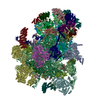
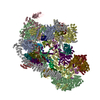



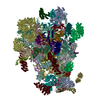
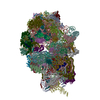
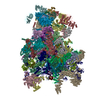




























 Z (Sec.)
Z (Sec.) Y (Row.)
Y (Row.) X (Col.)
X (Col.)






















































